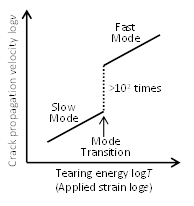
Atsushi Kubo
The University of Tokyo, Japan
Title: Finite-element analysis of velocity mode transition of crack propagation in rubber materials
Biography
Biography: Atsushi Kubo
Abstract
Crack propagation in rubber materials has been intensively investigated because it is one of fundamental processes of failure in rubber materials and is strongly related to the lifetime of rubber products. Some experiments have observed dynamic crack propagation in stretched rubber sheets and reported an interesting phenomenon called the "velocity mode transition". The mode transition is an abrupt change of tendency in the relationship between the crack propagation velocity and the tearing energy (or the loaded strain), as schematically shown in Fig. 1. There are two regions below and above a certain transition point, which are referred to as the "slow mode" and the "fast mode", respectively. According to the experiments, the crack velocity exhibits a nearly discontinuous change by more than two orders of magnitude at the transition point. While the behavior of a propagating crack at the fast mode can be explained theoretically, the mechanism of the mode transition phenomenon has been still unclear despite its importance. Furthermore, no numerical simulation has been established to reproduce the transition phenomenon thus far. In this talk, we present a series of analyses based on the finite element method (FEM) for purpose of revealing the mechanism of the mode transition phenomenon. We carried out FEM simulations of the pure-shear test to mimic a precedent experiment and obtained the relationship between the loaded strain and the crack propagation velocity. The material model consists of the hyper elasticity and viscosity, which were determined to reproduce the mechanical properties of a filled elastomer. As a result, the mode transition phenomenon was reproduced by the present FEM analyses, which revealed that the mode transition correlates to the viscoelastic behavior with a wide range of time scale. The mechanism of the transition phenomenon was well explained through a characteristic mechanical behavior at the crack tip.

Recent Publications
- Kubo A, Umeno Y (2017) Velocity mode transition of dynamic crack propagation in hyper viscoelastic materials: A continuum model study. Scientific Reports 7: 42305.
- Iskandarov A M, Kubo A, Umeno Y (2015) Development of a new dipole model: Interatomic potential for yttria-stabilized zirconia for bulk and surface. Journal of Physics: Condensed Matter 27: 015005.
- Umeno Y, Kubo A, Nagao S (2015) Density functional theory calculation of ideal strength of SiC and GaN: Effect of multi-axial stress. Computational Materials Science 109: 105-110.
- Kubo A, Wang J, Umeno Y (2014) Development of interatomic potential for Nd-Fe-B permanent magnet and evaluation of magnetic anisotropy near interface and grain boundary. Modeling and Simulation in Materials Science and Engineering 22: 065014.
- Kubo A, Albina J M, Umeno Y (2013) Atomistic study of stress-induced switching of 90-degree ferroelectric domain walls in PbTiO3: Size, temperature, and structural effect. Modeling and Simulation in Materials Science and Engineering 21: 065019.


